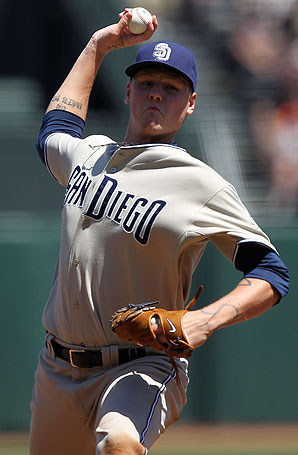Teams face decisions on how to use young aces down stretch
The San Diego Padres, for instance, already have shut down their ace, Mat Latos, for a two-week break. They want to cap his innings this year at about 150-170, and he would be on a pace to exceed 200 if they don't slow him down. Almost all teams don't want their young pitchers to increase their innings by more than about 30 from one year to the next.
Similar problems must be addressed with Price, Phil Hughes of the Yankees, Jaime Garcia of the Cardinals, Mike Leake of the Reds and Madison Bumgarner of the Giants.
It's a delicate balance. How often can you afford to skip one of your best starting pitchers while you're in a pennant race -- even when he's healthy? And do you keep a pitcher on schedule until he hits his limit, then shut him down, or do you borrow extra rest here and there to try to nurse him through the entire season -- and hope there is something left in the tank in October if you do make the playoffs?
Most teams who are out of the race will choose the former, as the Nationals apparently will do with Stephen Strasburg and the Orioles with Brian Matusz, Chris Tillman and Jake Arrieta. But the teams in the race likely will choose the more creative route, such as how Detroit treated Rick Porcello last year.
The Tigers gave Porcello 15 days of rest around the All-Star break and gave him extra rest for four of his 14 second-half starts. Porcello still wound up throwing 170.2 innings, a jump of 45.2 innings from the previous season. He has struggled in the majors this year (6.14 ERA) after the increased workload.
Here are the young pitchers with contenders this year who bear watching in the second half, including their age, previous high in innings, projected innings for the season (minors included in both cases), and the jump in their projected innings workload:
The most remarkable number to come out of the All-Star Game might have been the 100 mph clocking of Price's fastball, considering his average fastball velocity is 94 mph. Was he really throwing that hard?
"I don't know, but I'll take it," Price said. "I've never thrown a hundred before."
In truth, the gun Fox used on its telecast was a tick or two faster for the first couple of innings than the scoreboard readings at Angels Stadium. And Price admitted that an extra day of rest and the thrill of starting the All-Star Game gave his heater a boost.
"I haven't had that kind of adrenalin since the [2008] postseason," he said.
But whatever the exact reading, Price has been adding velocity to his fastball as he continues to grow into a front-of-the-rotation starter. On July 2 against Minnesota, for instance, he hit 99 mph and averaged 96 with his fastball. In his next start, against Boston, Price threw 100 fastballs out of his 111 pitches, topped out at 97 mph and averaged 95.
With an improved curveball and changeup, Price already has taken a leap forward this season in his progression as a pitcher. Added velocity has made him even more dangerous.
Sometimes a great year can be "hidden" because it spans two seasons. Ubaldo Jimenez of Colorado, for instance, went 24-4 over the past 365 days. Think about what Adam Wainwright and Chris Carpenter have done for the Cardinals since the All-Star break of last year -- a full year, if not exactly the same season. Here are their numbers from one break to another:
Now for some perspective on just how impressive it is for two teammates to run up those kinds of numbers in a "year." In the past 40 seasons, only one pair of teammates each has won 19 games with an ERA better than 2.75 and at least 34 starts: Ken Holtzman and Catfish Hunter of the 1972 A's. And the last time two Cardinals pitchers did something like that in the same season? It happened way back in 1904, when Kid Nichols and Jack Taylor did it.





